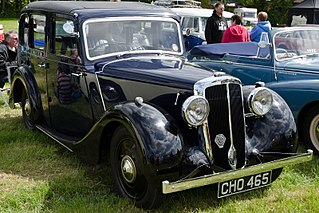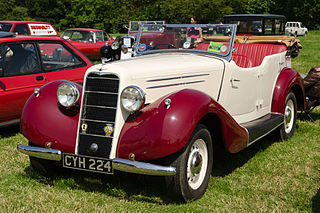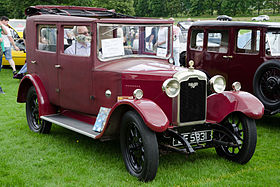
The Austin Sixteen Light Six is a British car that was made by Austin from 1927. Announced in October 1927, the first deliveries were planned for March 1928.

The Bentley S1 was a luxury car produced by Bentley Motors Limited from 1955 until 1959. The S1 was derived from Rolls-Royce's complete redesign of its standard production car after World War II, the Silver Cloud. Each was its maker's last standard production car with an independent chassis. The S-series Bentley was given the Rolls-Royce - Bentley L Series V8 engine in late 1959 and named the S2. Twin headlamps and a facelift to the front arrived in late 1962, resulting in the S3. In late 1965, the S3 was replaced by the new unitary construction Rolls-Royce Silver Shadow-derived T series.
Morris Cowley was a name given to various cars produced by Morris from 1915 to 1958.

The Morris Minor is a small 4-seater car with an 850 cc engine manufactured by Morris Motors Limited from 1928 until 1934. The name was resurrected for another newer car for the same market in 1948.

The Daimler Conquest is an automobile which was produced by The Daimler Company Limited in the United Kingdom from 1953 to 1958. Based on the Lanchester Fourteen, the Conquest replaced the Daimler Consort. Sales were affected by increasing prices and by the fuel shortage caused by the Suez Crisis, and production ended by January 1958, before a replacement model was in production.

The Wolseley Hornet is a six-cylinder twelve fiscal horsepower lightweight automobile which was offered as a saloon car, coupé and open two-seater as well as the usual rolling chassis for bespoke coachwork. Produced by Wolseley Motors Limited from 1930 until 1936, the Hornet was unveiled to the public at the end of April 1930. Wolseley had been bought from the receivers by William Morris in 1927.

The Rover Meteor was a short-lived 2½-litre or 2-litre medium-sized car made by The Rover Company Limited of Meteor Works Coventry. The new 2½-litre model was announced in mid-February 1930 to supplement Rover's Light Twenty which used the same engine and essentially the same chassis.

The Austin Light Twelve-Six is a 14 tax horsepower car with a 1496 cc engine that was introduced by Austin in January 1931. It was named by Austin Light Twelve to separate it from the well-established Austin Twelve. The general public then dubbed the original Twelve Heavy Twelve but Austin never used that name. The Light Twelve-Six remained in production until 1936.

The Hillman Fourteen is a medium-sized 4-cylinder car announced by Hillman's managing director Spencer Wilks, a son-in-law of William Hillman, at the end of September 1925. This new Fourteen substantially increased Hillman's market share and remained on sale into 1931. During this time it was the main product of the company.

The Rover 12 was a name given to several medium-sized family cars from the British Rover car company between 1905 and 1948.
The Rover 16/50 and Rover 16 are mid-sized cars which were produced by Rover from 1926 to 1929 and non-continuously from 1936 to 1947 respectively.

The Lanchester Ten and Lanchester Eleven were sold by The Lanchester Motor Company Limited from the Ten's announcement in September 1932 until 1951. Quite different from previous Lanchesters, the Ten was the second of Lanchester's new owner's new Daimler-linked Lanchester range. The names Ten and Eleven referred to the engine's rating for the annual tax and did not relate to the engine's power output.

The Lanchester Fourteen Roadrider is a six-cylinder automobile introduced by the Lanchester Motor Company in the beginning of September 1936. It was named "Roadrider" for its special suspension features, and billed as the lowest-priced six-cylinder Lanchester ever offered. This car replaced the previous 12 hp Light Six model with a larger six-cylinder engine again in the Lanchester Eleven chassis and body.
The Rover Fourteen was a medium-sized family car and variants produced by the British Rover car company between 1924 and 1948. Civilian automobile production was interrupted in 1940 because of the war, but when the war ended in 1945, the Rover 14 returned to the market and remained available until replaced by the Rover 75 at the beginning of 1948.

The Hillman Wizard 75, Hillman Twenty 70, Hillman Hawk and their long wheelbase variants Hillman Seven Seater and Hillman 80 models were a series of 20 horsepower medium priced 5-7 seater executive cars made by Hillman during the 1930s.

Morris Twelve is a model of Morris car introduced without fanfare in the autumn of 1934 as little more than a larger engined Morris Ten Four for which just another £5 was asked. The chassis and body were of the slow-selling longer wheelbase Ten Six. The engine though awarded a tax rating of 11.98 hp had a cubic capacity of 1548cc compared with Morris's 1292cc (10 hp) Ten Four and 1378cc (12.09 hp) Ten Six.

The Morris Six is a 2½-litre six-cylinder car with an overhead camshaft for its overhead valves first displayed at the October 1927 Motor Show at Olympia as Morris Light Six. When he bought Wolseley in February 1927 W R Morris gave Wolseley employees his reason. It was that he wanted to make good 6-cylinder cars and Wolseley could do that. He said he particularly admired their 2-litre Wolseley 16/45.

The Morris Oxford Six is a motor car produced by Morris of the United Kingdom from 1921 until 1926, and again from 1929 until 1935. Initially produced as a straight-six engined version of the Morris Oxford bullnose, the original Oxford Six was the first car produced by Morris with a six-cylinder engine, but proved to be unreliable. The versions produced from 1929 onwards were introduced as a replacement for the Morris Oxford 16/40.

The Rover 9 is a small car produced by Britain's Rover car company. It had a 1074 cc 9 fiscal horsepower four-cylinder engine. Manufactured from 1924 until 1927 it was first supplemented then replaced by Rover's 10-12 model.
The Rover Two-litre was a mid-size luxury open tourer, saloon or limousine produced from 1927 by the Rover Company of Coventry and available through to 1932. As usual the chassis was also available to coach builders.






































